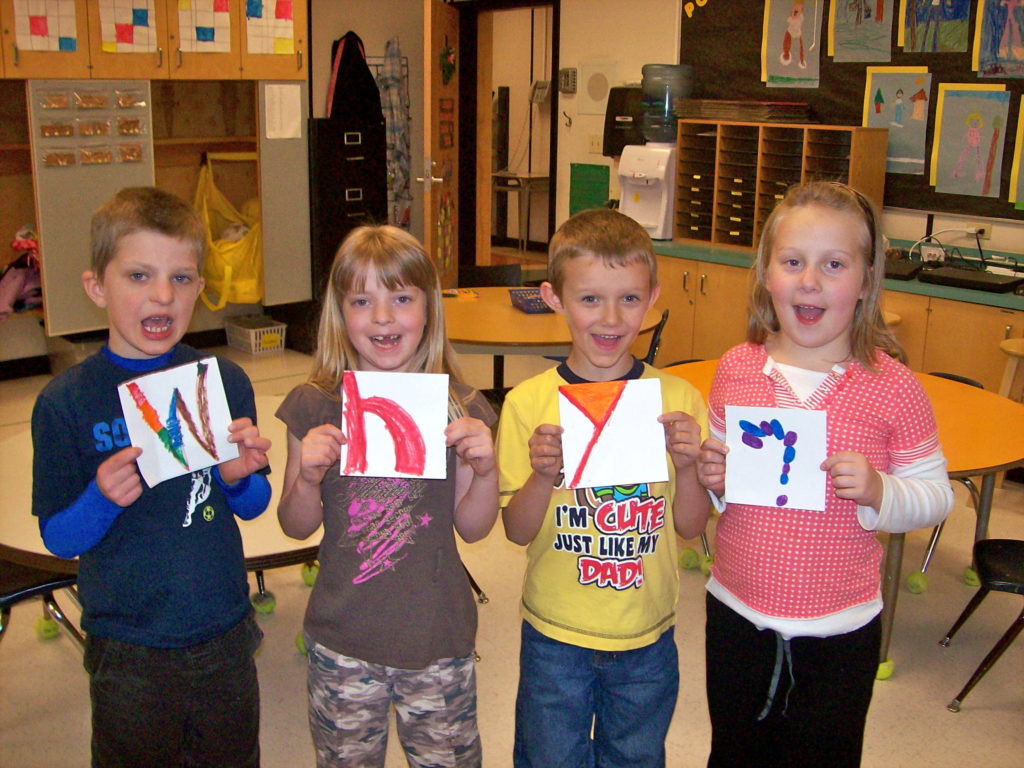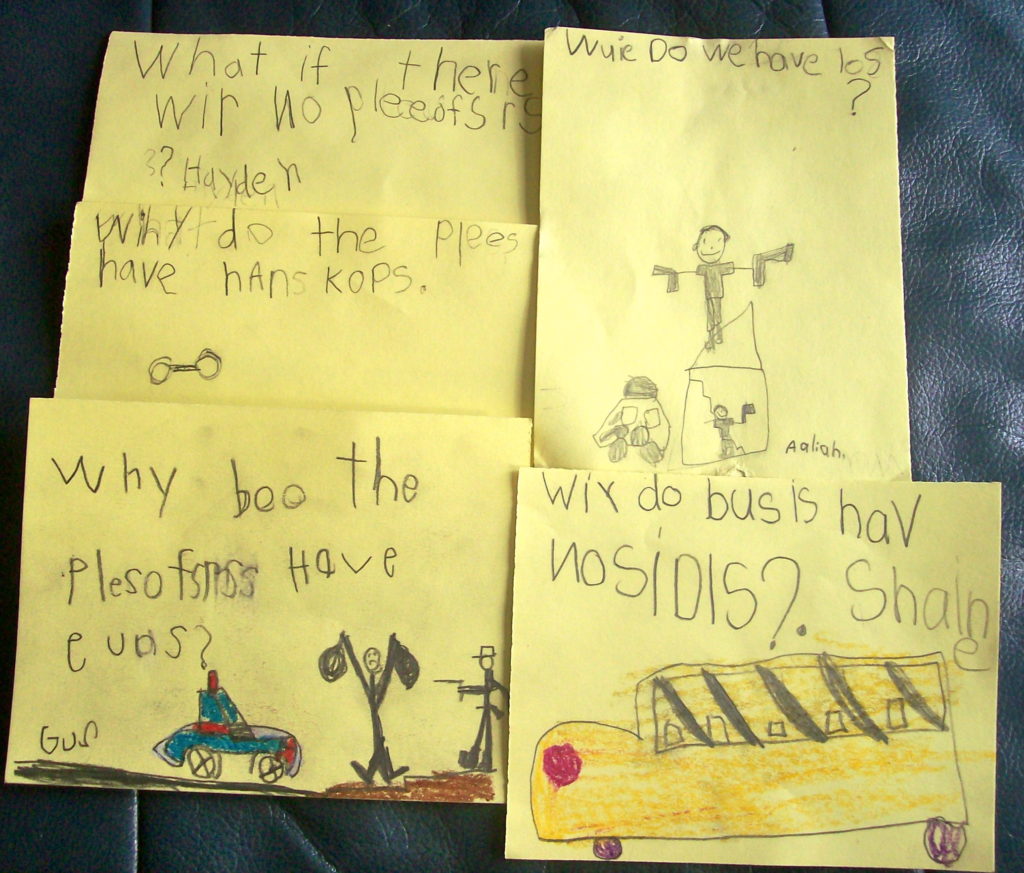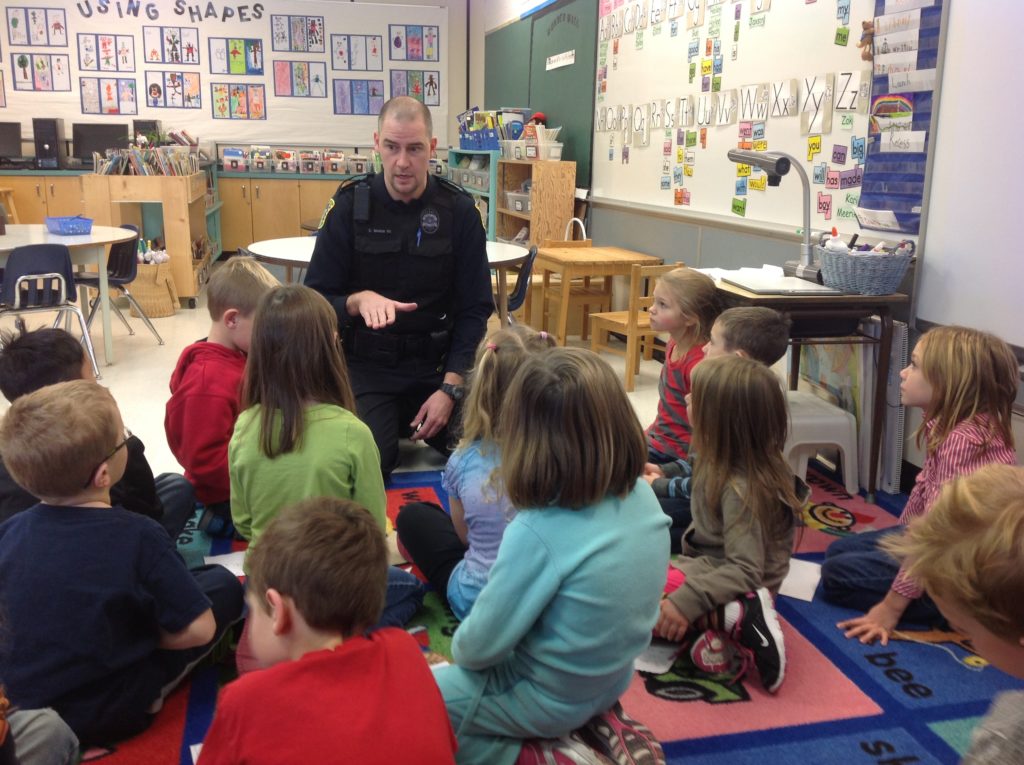
Asking questions is not hard for six-year-old students. Neither is telling stories about themselves. The problem for them is to know which is which.
I can’t tell you how many times a child has wanted to “ask a question” but has told me about something that happened at home the night before instead. (Primary teachers know way more than they should or even want to know about a student’s home life.)
Because we are doing inquiry or PBL (passion-based learning) this year, my students have asked more questions than ever before in my classroom. Both the students and I are still learning about this process, but I like this shift. The person who asks the questions is in charge of the learning, and I want my grade one kids to be in charge of their own learning early in their school careers.
Getting Ready to Meet a Police Officer

A few weeks ago, a police officer came to visit our classroom as a culmination of our “relationships, rules and responsibilities” unit. In the past, I have often asked the officers to talk to the students about a particular topic such as strangers or being safe on their bicycles. A constable would come into our classroom, talk for awhile, then answer a few questions from the kids, most of which were more likely to be story than inquiry.
This time, I told the officer I wanted the children to hear about ways to be safe, but I asked him to talk at the end about any safety topics were not covered by the students’ questions.
Because of the predisposition of a six-year-old to want to tell the constable every incident from their family’s history that might touch on law enforcement, we prepared the questions on cards ahead of time. We talked about what made a good question, the words that questions started with, and so forth. Then, as the students verbalized their wonderings, I gave them a card to write their question on. Those who are still having difficulty with letter/sound association drew a picture and I wrote their question out for them.
For some students, thinking of something they wanted to ask was difficult. Sometimes the questions were really stories and needed to be rethought. Sometimes I knew that the student already knew the answer to their question, so I helped them to reframe it to ask something else that they might be interested in knowing.
Asking the Questions
There were predictable questions such as “why do police officers have a gun?” and “why do the police have handcuffs?”. There were some interesting queries like “why do buses have no seat belts?” and “how do police officers arrest another police officer?”. And there were also some thoughtful, deeper questions such as “why do we have laws?” and “what if there were no police officers?”

Constable Mohle answered every question patiently and with serious intent. It was a validation for all of the students that the things they wanted to know were important. For me, this was a far more satisfying way to have a guest in the classroom. First, the students were more involved and not just passive listeners. Second, they learned that what they wonder matters to those from outside our classroom as well as those within it. And third, they practiced asking questions, an important skill.
If I ask the questions, I am in charge of the learning. If the police officer asks them, he is. If the students ask the questions they are in charge of their own learning. They did and they were.
As for my own question: I wonder what it is about the police officer’s uniform that instantly quiets my students and holds their undivided attention? And where can I legally get one?
An original version of this post appeared in this blog in April of 2012. It was written by Kathy Cassidy. Kathy is now giving away a free copy of her book “Connected from the Start” on her blog.
http://kathycassidy.com/2019/02/05/connected-from-the-start-is-now-free/
Kathy Cassidy
Latest posts by Kathy Cassidy (see all)
- Technology in the Classroom: Embrace the Bumpy Ride! - March 21, 2019
- Passion Based Learning (PBL) in Primary: Making Up the Rules - March 13, 2019
- Passion Based Learning (PBL) in the Primary Grades: Who Asks the Questions? - February 17, 2019


I really enjoyed reading you story. What you did is a great thing, bringing a police office to class and let students interact with him is what is called the contextualisation of learning. When students feel that what they learn at school is connected to their life outside the class, they become more interested in learning and perform better.
I agree! Making those connections is vital for student learning.
Fabulous Kathy! Thanks for sharing this and what it looks like in your classroom. I will share with as many people as I can!
Great article Kathy! Our young learners need more experiences like these.
I love your approach to how to get the most from a guest speaker! I will use this with my grade 12 chemistry students!
Thanks, Jane! Student really should be the ones asking the questions at any age, shouldn’t they?
Kathy –
Great stuff, as always. I’m continually amazed at what you do with your students! I love the post-it notes. I think some of my more reluctant “askers” might really appreciate this method. I can see posting a topic, and setting a 3-minute timer to have students brainstorm and write questions. Learning how to ask good questions is a critical skill – You are doing your students a huge service by teaching them how to do this at such an early age! LOVE IT!!
Great idea! That would work well with older students. We actually use a bit larger pieces of thin coloured cardboard–my students’ printing is still quite large so they need more space than even the larger post-it notes allow.
Kathy,
I so enjoyed reading your story! It brought home to me the important of questions within the process of learning. Questions should not be just asked by the instructor but the learners as well! I TOTALLY agree with you there!
What I also LOVED was the way you got your students thinking to ask questions. That is hard for any learner at any age – even adult ones!
Thanks for teaching your students this important skill!!!!!
The other way I’d think about doing the “sticky note” idea with older kids would be to let them use a back-channel tool like TodaysMeet to post questions (I find my reluctant askers in intermediate really like this) on a posted topic.
I LOVE the opportunity to pare stories down to questions that you gave your kids. We have an officer coming in a couple of weeks to talk about “sexting” with our 7’s and 8’s – wondering if we could set this approach up first.
If you have devices available, then yes, Today’s Meet is a great option.
I think having the students ask the questions would definitely work for your students as well. It really empowers students to allow them to be in charge of the learning. You will want to touch base with the officer before he comes to your classroom. They too are used to doing things the “old way” and it is nice for them to be prepared.
Hi Kathy,
Love, love, love it! I saw your post about the police officer visiting earlier in the spring but now that I have the back story it is so much more powerful! I, too, have students create their wonderings and work toward providing them with opportunities to discover the solutions. I am looking to implement deeper PBL for my students next year. Do you have any suggestions or great reads or sites that I should investigate?
Thanks for all the fabulous work you do, you inspire me to go further with my thinking and teaching!
Robyn
I feel pretty inadequate to recommend anything–I really feel like I am just starting on this journey myself. I am just beginning to read a book called Ladybugs, Tornadoes and Swirling Galaxies, but it may be more oriented towards emerging readers than would be appropriate for your students. Everything I have bookmarked about PBL is here: http://www.diigo.com/user/kathycassidy/pbl?type=all I hope you can find something that is useful to you.
Thanks so much Kathy. I read the Ladybug….book a few years ago and did find it to be more suited to the younger grades. I am ever grateful for your help and your diigo page is amazing! So much to think about and read!
Robyn